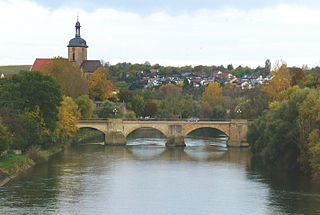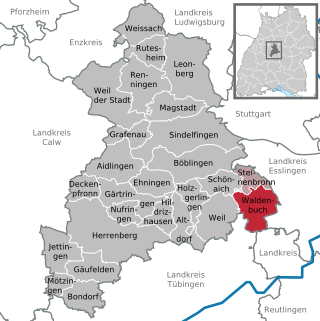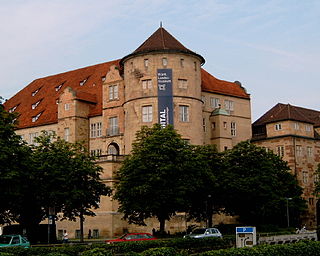
Schillerplatz is a square in the old city centre of Stuttgart, Germany named in honour of the German poet, philosopher, historian, and dramatist Friedrich Schiller. Schillerplatz stands to the south west of Stuttgart's main square, Schlossplatz.

Schillerplatz is a square in the old city centre of Stuttgart, Germany named in honour of the German poet, philosopher, historian, and dramatist Friedrich Schiller. Schillerplatz stands to the south west of Stuttgart's main square, Schlossplatz.

Starting in the south west corner, Schillerplatz is surrounded by the Stiftskirche (Collegiate Church), the Fruchtkasten building, the Prinzenbau (which now houses the Baden-Württemberg Ministry of Justice, the Alte Kanzlei (Old Chancellery) and Altes Schloss (the Old Castle).
A street market takes place twice a week on Schillerplatz. The square is also used for major events taking place on Marktplatz (Stuttgart's Market Square) such as the annual Christmas Market. Hidden underneath Schillerplatz's cobblestones is an underground car park.
The late Gothic Fruchtkasten building in the corner of Schillerplatz is now used by the State Museum of Württemberg to house a collection of musical instruments.

At the centre of the cobblestone square is a memorial to Friedrich Schiller which was erected in 1839 by the Danish sculptor Bertel Thorvaldsen. Thorvaldsen's statue was the first memorial to Schiller to be erected in Germany.

The first known brick building in Stuttgart - the Stuthaus or mare house - stood next to the adjacent Stiftskirche (collegiate church). It is therefore supposed that the square was originally used as a horse breeding area around 1000 years ago (in keeping with Stuttgart's history). After the 12th century the square was probably covered in simple houses before other stone houses such as the Fruchtkasten were built. In the mid-14th century the Dürnitzbau wing of the Old Castle (next to Schillerplatz) was erected. The Old Chancellery was built in 1542 shortly before completion of the Arkadenflügel wing of the Old Castle. The area between the Old Castle and the Chancellery became a moat.[ citation needed ]
In 1594 Duke Friedrich I asked his master builder Heinrich Schickhardt to turn today's Schillerplatz into a Renaissance square. Residents' houses were bought and demolished. The new square was laid with cobblestones and called 'Castle and Chancellery Square'. The dimensions of the square have not changed since.[ citation needed ]
In 1607 work began on the Gesandtenhaus (a type of ambassador's house) which is now known as the Prinzenbau and was finally completed in 1677. In 1711 the Prinzenbau was extended behind the Old Chancellery with an arch in the northernmost corner of Schillerplatz. On the opposite, southern side of the square between the Old Castle and Stiftskirche the first Stuttgart Café opened in 1712. It was replaced in 1798 by the König von England inn (King of England Inn). This was shortly after the moat surrounding the Old Castle had finally been filled in leaving the square the way it stands today.[ citation needed ]
The square was officially renamed Schillerplatz in 1934 in memory of one of Baden-Württemberg's most famous writers and intellectuals.[ citation needed ]
During the Second World War of the buildings around Schillerplatz were burnt down but all were reconstructed after the war with the exception of the King of England Inn.
The underground car park was built in 1972-3.

Aalen is a town located in the eastern part of the German state of Baden-Württemberg, about 70 kilometres (43 mi) east of Stuttgart and 48 kilometres (30 mi) north of Ulm. It is the seat of the Ostalbkreis district and is its largest town. It is also the largest town in the Ostwürttemberg region. Since 1956, Aalen has had the status of Große Kreisstadt. It is noted for its many half-timbered houses constructed from the 16th century through the 18th century.

Stuttgart is the capital and largest city of the German state of Baden-Württemberg. It is located on the Neckar river in a fertile valley known as the Stuttgarter Kessel and lies an hour from the Swabian Jura and the Black Forest. Stuttgart has a population of 632,865 as of 2022, making it the sixth largest city in Germany, while over 2.8 million people live in the city's administrative region and nearly 5.5 million people in its metropolitan area, making it the fourth largest metropolitan area in Germany. The city and metropolitan area are consistently ranked among the top 5 European metropolitan areas by GDP; Mercer listed Stuttgart as 21st on its 2015 list of cities by quality of living; innovation agency 2thinknow ranked the city 24th globally out of 442 cities in its Innovation Cities Index; and the Globalization and World Cities Research Network ranked the city as a Beta-status global city in their 2020 survey. Stuttgart was one of the host cities for the official tournaments of the 1974 and 2006 FIFA World Cups.

Tübingen is a traditional university city in central Baden-Württemberg, Germany. It is situated 30 km (19 mi) south of the state capital, Stuttgart, and developed on both sides of the Neckar and Ammer rivers. As of 2014 about one in three of the 90,000 people living in Tübingen is a student. As of the 2018/2019 winter semester, 27,665 students attend the Eberhard Karl University of Tübingen. The city has the lowest median age in Germany, in part due to its status as a university city. As of December 31, 2015, the average age of a citizen of Tübingen is 39.1 years.

Baden-Baden is a spa town in the state of Baden-Württemberg, south-western Germany, at the north-western border of the Black Forest mountain range on the small river Oos, ten kilometres east of the Rhine, the border with France, and forty kilometres north-east of Strasbourg, France.
The Zollernalbkreis is a Landkreis (district) in the middle of Baden-Württemberg, Germany. The district is located in the Swabian Alb, and contains the second highest elevation of this range, the 1,011-metre (3,317 ft) high Oberhohenberg. In the south-east the district nearly reaches to the river Danube.

Solitude Palace is a Rococo schloss and hunting retreat commissioned by Charles Eugene, Duke of Württemberg. It was designed by Johann Friedrich Weyhing and Philippe de La Guêpière, and constructed from 1764 to 1769. It is located on an elongated ridge between the towns of Leonberg, Gerlingen and Stuttgart in Baden-Württemberg.

Nagold is a town in southwestern Germany, bordering the Northern Black Forest. It is located in the Landkreis (district) of Calw (Germany/Baden-Württemberg). Nagold is known for its ruined castle, Hohennagold Castle, and for its road viaduct. It takes its name from the river Nagold, which flows through the town.

Leonberg is a town in the German federal state of Baden-Württemberg about 16 km (10 mi) to the west of Stuttgart, the state capital. About 45,000 people live in Leonberg, making it the third-largest borough in the rural district of Böblingen.

Pfullingen is a town in the district of Reutlingen, Baden-Württemberg, Germany. It is situated 3 km southeast of Reutlingen at the foot of the Swabian Alb. With its almost 20,000 inhabitants it is famous for its Handball team, which in 2006 had to file for bankruptcy, the Schönbergturm and the People mover.

Bad Friedrichshall is a town in the district of Heilbronn in Baden-Württemberg in southern Germany. It is situated at the confluences of the Jagst and of the Kocher into the Neckar, some 10 kilometres (6 mi) north of Heilbronn. Bad Friedrichshall arose by the connection of Kochendorf and Jagstfeld in 1933, and is famous for its salt mine.

Lauffen am Neckar or simply Lauffen is a town in the district of Heilbronn, Baden-Württemberg, Germany. It is on the river Neckar, 9 kilometres southwest of Heilbronn. The town is famous as the birthplace of the poet Friedrich Hölderlin and for its quality wines – in particular the "Lauffener Katzenbeißer Schwarzriesling".

Waldenbuch is a town in the district of Böblingen, Baden-Württemberg, Germany.

The Old Palace is a former castle located on the Schillerplatz in Stuttgart, Germany. The castle, originally a water castle dating back to the 10th century, was the residence of the Counts and later some Dukes of Württemberg and today is the home of the Landesmuseum Württemberg. The castle church still functions as a place of worship.

Schlossplatz is the largest square in Stuttgart Mitte and home to the Neues Schloss which was built between 1746 and 1807. From its construction until the mid-1800s it was used as a military parade ground and not open to general public use. It stands next to two other popular squares in Stuttgart: Karlsplatz to the south and Schillerplatz to the south west. The Königstraße bisects the plaza from north to south.

The Württemberg Mausoleum is a mausoleum located on the Württemberg, in the Rotenberg borough of Untertürkheim, in Stuttgart. It was designed by Giovanni Salucci for King William I of Württemberg to house the remains his second wife, Catherine Pavlovna of Russia. Construction elapsed over four years, from 1820 to 1824, while work on its decor lasted another four years. The remains of William I, Catherine, and their daughter Maria Friederike Charlotte, are housed in the mausoleum.

The Landesmuseum Württemberg is the main historical museum of the Württemberg part of the German state of Baden-Württemberg. It emerged from the 16th-century “Kunstkammer” of the dukes, later kings, of Württemberg who resided in Stuttgart. As a museum it was founded in 1862 by King William I.

With an area of more than 30 hectares, the Hohenheim Gardens are the largest part of the campus of the University of Hohenheim in Stuttgart, Baden-Württemberg, Germany. The oldest part of the garden, the Exotic Garden or Franziskas Dörfle, was established in 1776 by Duke Carl Eugen von Württemberg and Franziska von Hohenheim. Today, the Hohenheim Gardens are home to around 3000 taxa of woody plants as well as numerous monuments and works of art from four centuries. Over 150 woody plants are more than 100 years old. The Hohenheim Gardens are open all year round, all day and free of charge.

The Stiftskirche is an inner-city church in Stuttgart, the capital of Baden-Württemberg, Germany. It is the main church of the Evangelical-Lutheran Church in Württemberg as well as the parish church of the evangelical (Lutheran) inner-city church district of Stuttgart.
The following is a timeline of the history of the city of Stuttgart, Germany.

The Schillerplatz is a cobblestoned square in Blasewitz part of Dresden, Germany. A square has been named after Friedrich Schiller, a German dramatist, poet, and historian.